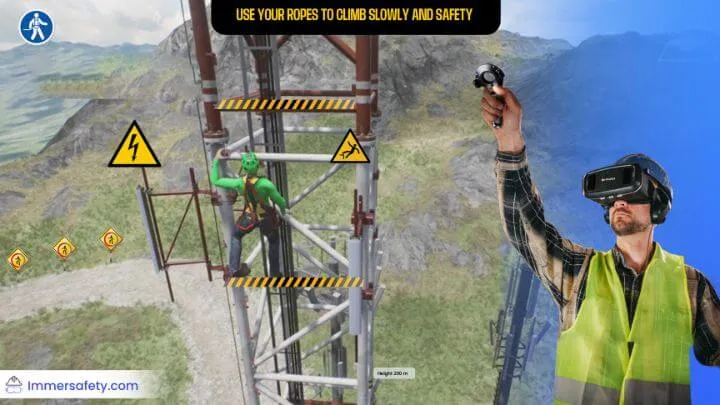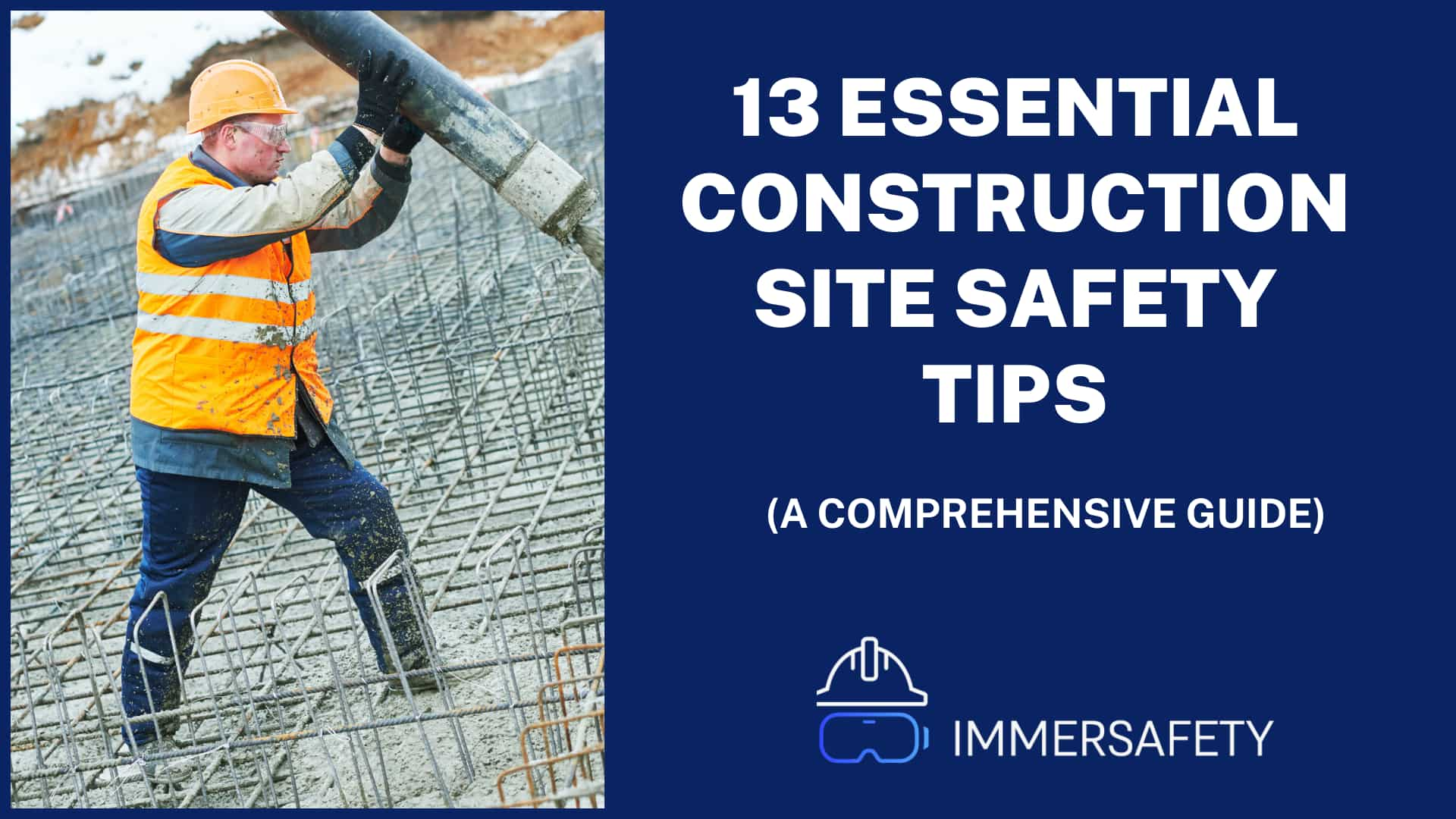Construction sites are dynamic environments that involve various activities, heavy machinery, and complex processes. While these sites are essential for creating our built environment, they also present significant safety challenges.
Prioritizing construction site safety is crucial to prevent accidents, injuries, and even fatalities.
In this blog post, we will delve into 13 essential construction site safety tips to create a safer and more secure working environment for all personnel involved.
13 Essential Construction Site Safety Tips For Workers, Beginners & Managers

1. Provide Adequate Training:
Ensuring the safety of construction sites begins with comprehensive training. Workers must be equipped with the knowledge and skills needed to navigate the complexities of the job. Proper training covers various aspects, from mastering equipment operation and recognizing potential hazards to swiftly executing emergency procedures.
This foundational training ensures that workers are well-prepared to handle their tasks with a keen eye on safety, fostering a culture of awareness and responsibility.
2. Use Personal Protective Equipment (PPE):

Personal Protective Equipment, or PPE, is the frontline defence against potential construction site hazards. Hard hats shield heads from falling debris, safety goggles safeguard eyes from dust and debris, gloves shield hands from sharp materials, and steel-toed boots offer protection against heavy objects. Wearing PPE is not just a requirement; it’s a commitment to personal safety.
By consistently donning these protective items, workers minimize the risks associated with their work tasks and demonstrate a dedication to their own well-being.
3. Implement Fall Protection Measures:
In the realm of construction, falls constitute a significant threat. To counter this danger, implementing effective fall protection measures is crucial.
Guardrails act as sturdy barriers along elevated edges, safety nets provide a reliable catchment system, and personal fall arrest systems offer a lifeline to workers in precarious positions.
By incorporating these measures, construction sites create a safer environment where the risk of falls from heights is dramatically reduced.
4. Control Hazardous Energy:
Uncontrolled energy can lead to devastating accidents. Lockout/tagout procedures form a vital defence against unexpected equipment activation.
Workers trained in proper energy isolation techniques are empowered to disable machinery and secure energy sources before maintenance or repairs.
This proactive approach prevents hazardous energy from causing harm, fostering a workplace where equipment-related injuries are minimized through systematic precautions.
5. Regular Equipment Inspection:
Construction machinery is the backbone of any project, making regular inspection a non-negotiable safety measure. Routine assessments uncover potential defects or malfunctions that could compromise worker safety.
Identifying issues early on allows for timely repairs and adjustments, ensuring that equipment operates smoothly and reliably.
By prioritizing regular equipment inspections, construction sites cultivate an environment of vigilance and proactivity that safeguards workers from preventable accidents.
6. Safe Scaffolding Practices:
Scaffolding is a crucial tool in construction, but its safe use demands precision. Competent personnel must oversee its erection, ensuring it meets stability and load-bearing standards. Regular inspections further validate its integrity, identifying any signs of wear, weakness, or misalignment.
These proactive steps solidify the scaffolding’s reliability, creating a secure platform for workers to execute their tasks. By adhering to safe scaffolding practices, construction sites foster an atmosphere of meticulous care that safeguards workers against potential hazards at elevated work sites.
7. Proper Material Handling:
The proper handling of materials is pivotal for averting musculoskeletal injuries and accidents. Equipping workers with training on effective lifting techniques minimizes the strain on their bodies.
Additionally, providing specialized equipment like forklifts and cranes streamlines material movement, reducing the risk of mishaps.
This emphasis on proper material handling techniques underscores a commitment to worker well-being, promoting a construction site where tasks are performed efficiently and with a keen awareness of potential physical strains.
8. Electrical Safety:

Electrical hazards pose significant risks on construction sites, demanding utmost caution. Licensed professionals are entrusted with electrical installations, ensuring compliance with safety codes and regulations.
Workers must be educated about these hazards and trained in the correct handling of electrical equipment. This knowledge empowers them to navigate potentially dangerous situations, minimizing the likelihood of electrical accidents.
By prioritizing electrical safety, construction sites cultivate an environment where the potential for electrocution or fires is significantly reduced.
9. Fire Prevention and Preparedness:

The threat of fire is ever-present on construction sites, necessitating comprehensive fire prevention measures. Proper storage of flammable materials, coupled with strategically placed fire extinguishers, forms a strong defence against potential blazes.
Regular fire drills rehearse emergency response protocols, ensuring that all personnel are well-prepared to handle fire-related emergencies.
Embracing fire prevention and preparedness protocols instils a sense of readiness and vigilance, creating a construction site where the potential for devastating fires is mitigated.
10. Communication is Key:
Effective communication is the cornerstone of a safe construction site. Clear communication channels are established through warning signs, signals, and reliable communication devices.
These mechanisms facilitate seamless interactions between workers and machinery operators, reducing the risk of misunderstandings and potential accidents. By prioritizing communication, construction sites foster an environment where information flows freely, fostering collaboration and awareness that contribute to a safer work environment.
11. Traffic Management:
The orchestrated movement of vehicles and heavy equipment on construction sites requires vigilant traffic management.
Designated pathways separate pedestrians from vehicular traffic, minimizing the potential for collisions. Proper signalling, including visible signs and clear directives, further guides movement and interactions.
By meticulously planning and enforcing traffic management protocols, construction sites create an environment where the risk of accidents stemming from vehicular or equipment-related mishaps is significantly curtailed.
12. Proper Waste Disposal:
The responsible disposal of waste is a cornerstone of a safe and health-conscious construction site. With copious waste generated, adherence to disposal guidelines is paramount. Proper segregation and disposal of hazardous materials prevent environmental contamination and potential health risks.
Ensuring waste materials are contained and removed in accordance with regulations not only maintains site cleanliness but also underscores a commitment to worker and public well-being. By prioritizing proper waste disposal, construction sites uphold ethical and safety standards, minimizing the potential for harm.
13. Regular Safety Meetings and Training Refreshers:
Sustained safety awareness requires continuous efforts, achieved through regular safety meetings and training refreshers. These gatherings serve as platforms to address evolving risks, share insights, and reinforce established safety protocols.
By consistently revisiting and reinforcing safety practices, construction sites ensure that safety remains ingrained in the minds of all personnel.
This proactive approach fosters a culture of diligence, where every worker is an active participant in upholding safety standards, ultimately creating a construction site where risk is minimized, and well-being is prioritized.
Final Thoughts About Construction Site Safety Tips
Construction site safety is a collective responsibility that requires continuous vigilance, proactive measures, and a commitment to best practices. By following these 13 essential construction site safety tips, stakeholders can create a safer work environment that minimizes the risk of accidents and injuries.
Prioritizing safety not only protects the well-being of workers but also contributes to more efficient and successful construction projects. Remember, a well-organized and secure construction site is the foundation for a successful build and a healthier workforce.
Discover a new dimension in safety learning. Contact us now for a personalized demo of Virtual Reality For Safety Training.


